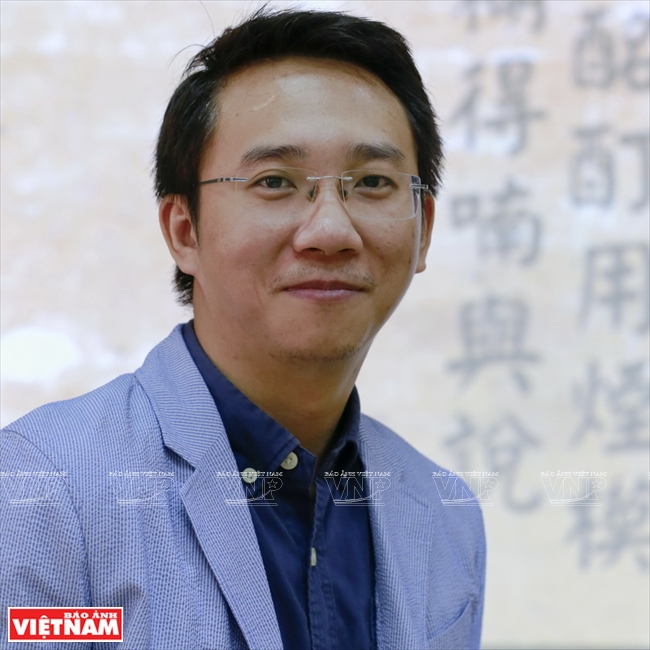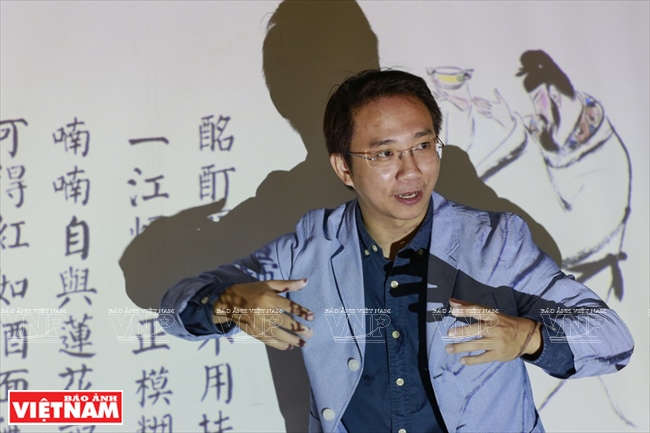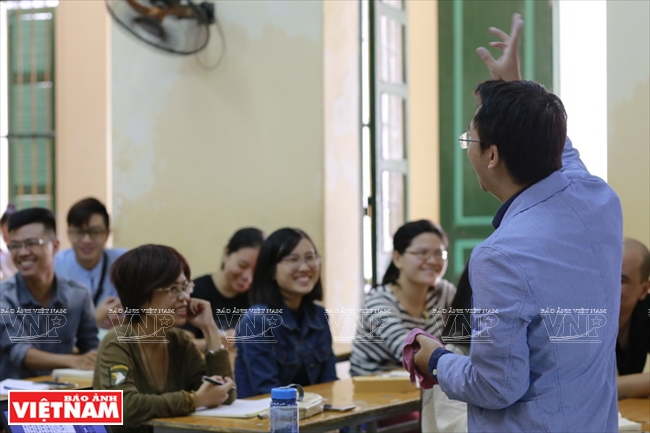With the launch of his book “Ngan nam ao mu” (A thousand years of caps and robes), Tran Quang Duc, a researcher of Han Nom (classical Chinese and Chinese-transcribed Vietnamese) born in the 1980s, has created a phenomenon in the field of cultural studies which is inherently academic.
A phenomenon in the research book market
In 2013, “Ngan nam ao mu” made its debut, immediately creating a stir in the market of Vietnamese research books.
Some 1,000 copies of the book were sold immediately after its launch and another 7,000 copies were sold in its second edition which followed just one month later.
Nha Nam, a communication company known for having flair in the book market in Vietnam could not predict the soaring popularity of the book.

Young researcher Tran Quang Duc.

Duc always incorporates cultural issues in his Han Nom classes.
|
“Ngan nam ao mu” is one of the few research books that is convincing in professional circles. In 2014, it won a prize in the “New Findings” category.
“Ngan nam ao mu” started as a small ambition of overseas student Tran Quang Duc, who returned home after graduating from Beijing University in 2009. At that time, producers of Vietnamese historical dramas were struggling with the issue of ancient costumes, which bore almost no difference to the Chinese. This prompted the young student to write a book to “offset the immense gap in Vietnam’s history of clothing and culture”.
“Ngan nam ao mu” deals with clothing worn by Vietnamese people during a 1000-year period from the Ly dynasty to the Nguyen dynasty (1009 – 1945). The author gives deep analysis of royal garments (worn by emperors, kings and bureaucrats including ceremonial attire; military uniforms and folk costumes (clothes and hairstyles).
“Ngan nam ao mu is perhaps one of the most well-researched-and-documented collections of Vietnam’s culture and history of clothing so far.”
Researcher Trinh Bach. |
Dream to convey knowledge
Duc had a dream of conveying knowledge by working as a teacher. He opened a Han Nom class to interact with and spread knowledge to people having the same interest in Han Nom, who, after completing their courses, could translate books.
Despite the academic nature of this class and its selective students, seven courses were held by October 2017 and new courses are opened regularly.
Another purpose of Duc’s Han Nom class is to “finalise a Han Nom textbook which can be read by a majority of Vietnamese, helping them understand the eating and thinking habits of their predecessors.” Therefore, the class textbook is updated after each course to meet the needs of students.Young

The textbook of Duc's Han Nom classes is updated after each course to meet the needs of students.

Duc's Han Nom classes largely attract persons interested in ancient culture.
|
According to Duc “Whatever you do, the most important thing is to have a scientific, logical, and effective mindset.” The 8x- generation scholar does not mind when others use the word “start-up” when referring to his current job.
The way in which a person starts their business may be different depending on the era they are living in. But Tran Quang Duc has found the key for cultural researchers like him to get community recognition, saying: “Every person who lives in modern times carries on their shoulders the weight of the past which they are not aware of. My job is to help them understand that the perfection in every human is connected to the past.”
Story: Thao Vy – Photos: Viet Cuong